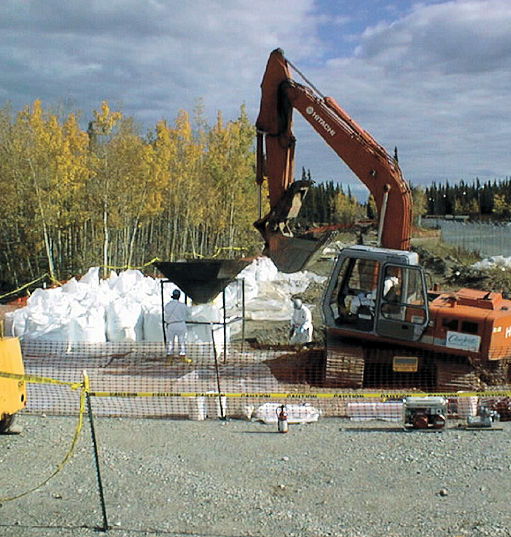Drum Excavation and Removal Equipment
Drum excavation and removal equipment is used to perform several distinct and important functions, including:
- excavating to the depth of buried drums and removing surface cover over buried drums,
- removing (lifting) drums from exposed pits and trenches,
- loading and transporting drums to onsite storage areas,
- sampling, segregating, bulking, storing, and recontainerizing (e.g., overpacking) drums, and
- transporting offsite for appropriate storage, treatment, or disposal.
The choice of equipment for drum handling is based on the inherent capabilities and limitations of the equipment, site-specific conditions that affect equipment performance, the necessity to protect worker safety, and costs.
- Select vehicles with sufficient rated load capacity to handle anticipated loads, and ensure that vehicles can operate smoothly on available road surfaces.
- Air condition the cabs of vehicles to increase operator efficiency and protect the operator with heavy splash shields.
Staging and Opening Drums and Containers
Staging and opening drums and containers can result in unexpected spills and exposure to hazardous substances. Procedures for staging and opening drums are the same, regardless of where the drums are opened. Be sure to do the following when opening drums:
- Stage potentially explosive or shock-sensitive wastes in a diked, fenced area. Use remote drum opening methods where drums are unsound.
- Stage gas cylinders in a cool, shaded area.
- Fire extinguishing equipment meeting the requirements of 29 CFR Part 1910, Subpart L, must be on hand and ready for use to control incipient fires.
- Use non-sparking bronze-beryllium tools when possible;
- Where an airline respirator system is used, connections to the source of air supply must be protected from contamination, and the entire system must be protected from physical damage.
- If a supplied-air respiratory protection system is used, place a tank of air cylinders outside the work area and supply air to the operators via airlines and escape SCBAs;
- Employees not actually involved in opening drums or containers must be kept a safe distance from the drums or containers being opened.
- If employees must work near or adjacent to drums or containers being opened, a suitable shield that does not interfere with the work operation must be placed between the employee and the drums or containers being opened to protect the employee in case of accidental explosion.
- Controls for drum or container opening equipment, monitoring equipment, and fire suppression equipment must be located behind the explosion-resistant barrier.
- When there is a reasonable possibility of flammable atmospheres being present, material handling equipment and hand tools must be of the type to prevent sources of ignition.
- Drums and containers must be opened in such a manner that excess interior pressure will be safely relieved. If pressure cannot be relieved from a remote location, appropriate shielding must be placed between the employee and the drums or containers to reduce the risk of employee injury.
- Employees must not stand on or work from drums or containers.
- Conduct air monitoring during drum-opening activities.
Knowledge Check Choose the best answer for the question.
3-6. What must be done to protect employees from accidental explosion if they must work near or adjacent to drums being opened?
You forgot to answer the question!

